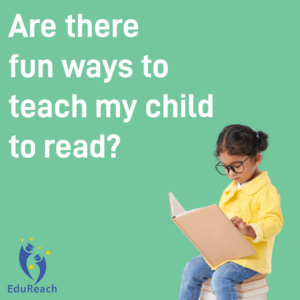Are there fun ways to teach my child to read?
Contrary to what some people might believe, learning to read is not a natural process that happens on its own. It is a complex one that requires the proper teaching of various skills and strategies like phonics – knowing the relationship between letters and sounds – and phonemic awareness.
The good news is that although reading itself is a complex process, the steps taken in order to build these skills are fairly simple and straightforward. In order to teach children how to read and make it a positive and rewarding experience, try these simple and time-tested strategies.
- Use songs and nursery rhymes to build phonemic awareness
Children’s songs and nursery rhymes aren’t just a lot of fun – the rhyme and rhythm help them hear the sounds and syllables in words, which helps them learn to read. A good way to build phonemic awareness is to clap rhythmically together and recite songs at the same time. This playful and bonding activity is a fantastic way for children to implicitly develop the literacy skills that will set them up for reading success.
- Make simple word cards at home
Cut out simple cards and write a word containing these sounds on each one. Invite your child to choose a card, then read the word together and hold up three fingers. Ask them to say the first three sound they hear in the word, then the second, then the third. This simple activity requires a little prep-time and builds essential phonic and decoding skills by helping them learn how to sound out words. If your child is just starting out with learning the letters of the alphabet, focus on the sound each letter makes.
- Engage your child in a print-rich environment
Create daily opportunities to build your child’s reading skills by creating a print-rich environment at home. Seeing printed words – on posters, charts, books, labels – enables children to see and apply connections between sounds and letter symbols. When you’re out and abut, point out letters on posters and signages. In time, you can model sounding out the letters to make words. Focus on the first letter in words. Ask your child what sound a letter makes, or what other words start with that sound, or what word rhymes with that word.
- Play word games at home
Building on from the previous step, introduce simple word games on a regular basis. Focus on playing games that encourage your child to listen, identify and manipulate the sounds in words. For example, start by asking questions like “What sound does this word start with?”, “What sound does this word end with?”, “What words start with this sound?” and “What word rhymes with this word?”.
- Use technology to keep your child engaged
Learning to read should be an enjoyable process in order to keep kids motivated and improve. Sometimes a child might be full of excitement and eagerness to learn at the beginning, but once they hit a wall, they can feel overwhelmed and give up easily. As a parent, it can feel impossible to pick up again and know where to fill in any gaps that may be causing frustration.
There are many apps out there (for example, ABC Reading Eggs) that use self-paced lessons that match each child’s ability. Children are regularly rewarded for completing activities and reaching new levels, which keeps them motivated to stay on track. Parents can also keep track of progress to see how a child’s skills are improving.
- Read together on a daily basis and ask questions about the book
A lot of people don’t realise just how many skills can be picked up through the simple act of reading to a child. Not only are you showing them how to sound out words, but you’re also building key comprehension skills, growing their vocabulary, and letting them hear what a fluent reader sounds like. Most of all, regular reading helps your child to develop a love for reading, which is the best way to stem them up for reading success.
Strengthen your child’s comprehension skills by asking questions while reading. For younger children, encourage them to engage with the pictures. For older children, ask them questions about what you’ve just read, like “Why do you think the little boy was afraid?” or “When did she realise that she had special powers?”

